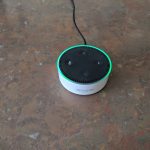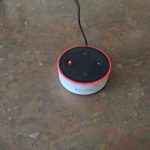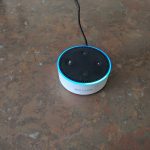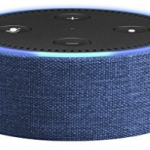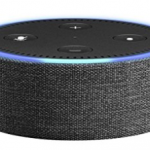Smart speakers are taking over. In Australia we’re beginning to be spoiled for choice with Google, Apple and Amazon all offering options. These days, buying a smart speaker is essentially buying into an eco-system, but support for hardware and software services not exactly equal across all three companies.
The best way to check out which smart speaker eco-system is for you is to get the cheapest option and see how it goes. Apple is of course not helping themselves offering only a single $499 option, but Google and Amazon both offer entry level options with the Home Mini and Echo Dot speakers starting at just $79.
Of course both Google and Amazon offer discounts on their respective speakers, so if you time it right you can get an even better deal on either. We tried out the Google Home Mini when it launched, and we’re now taking the Amazon Echo Dot for a spin to see how it fares, so let’s get into it.
Design and Hardware
The key word when it comes to the Amazon Echo Dot is simplicity. The design is simple, and it’s sized merely large enough to include all the components you need for a smart speaker.
For an Amazon Echo speaker, this means it includes the same seven far-field microphone array built into the top of the speaker which you find on the larger Echo speakers.
Also on the top is the same physical buttons as the Echo, four buttons cutting a cross through the top of the Echo: Volume up and down above each other, with a mute or privacy button to the left, and an activation button to call Alexa without actually saying ‘Alexa’ on the right.
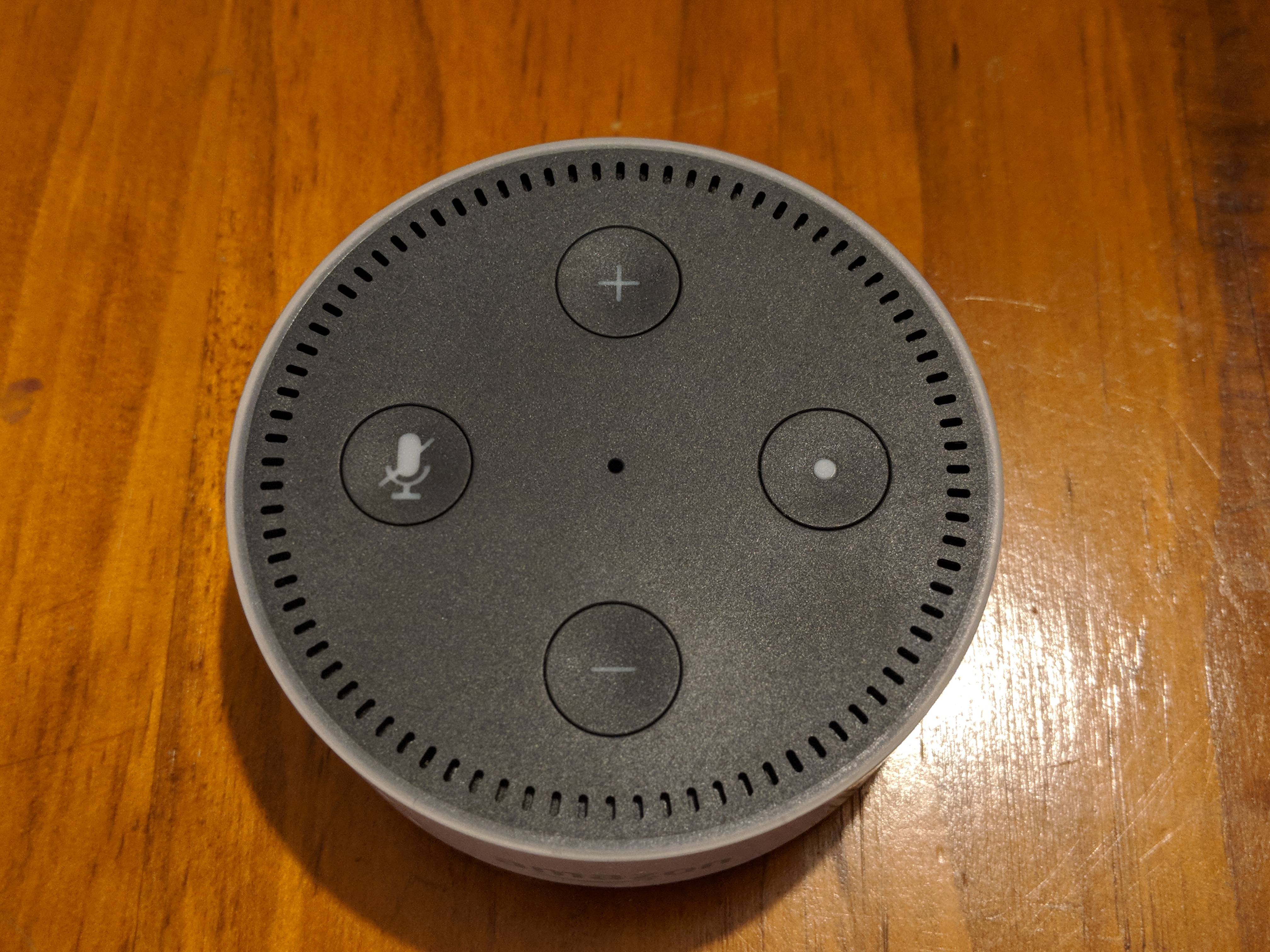
The speaker on the Echo Dot though is absolute bare minimum, with a tiny 0.6″ tweeter and no woofer. This means when the speaker plays voice or music you’ll get a slightly tinny sound, with no real depth.
The Echo Dot, like the larger Echo and Echo Plus, also includes an LED ring around the top which changes colour depending on the situation. It lights up blue when listening to you, or a pinkish/red when you hit the mute switch on top. There’s a third colour – Green – which lights up when you’re in a call using the Alexa calling function.
Amazon offers only two colour choices for the plastic bodied Echo Dot, you can get either black or white for your $79, but if you’re wanting more options there are fabric cases in Indigo, Charcoal or Sandstone colour options to wrap your Echo Dot in for an additional $20.95.
I have both a White Echo Dot review unit and a Black one I purchased during a visit to the US, and I think I may get a sandstone wrap for each just to make them match my larger Echo. It makes my OCD twitch less, even if they’re in different rooms.
Audio
Microphones
Amazons 7-mic far field array is really good. This array of microphones is what lets the Echo’s built-in virtual assistant, Alexa, hear you even when the audible din of a busy home is at its peak. In the kitchen where my Echo Dot is placed, with a microwave going, pots and pans bashing around, the TV on in the background and a seven year old running amok, Alexa responds almost every time.
I’ve also got a Google Home Mini in the Kitchen, and in comparison the Echo Dot seems to hear a lot better. That’s not to say the Echo Dot is perfect, because it does miss sometimes, but it’s damn close.
Speaker
I’m not that into music, tending towards listening to podcasts, so for me I find the small speaker, which is just a tweeter in the Echo Dot just fine most of the time. But my wife is definitely a music kinda gal, so it doesn’t really pass muster for her. This is when the ability to either pair the Echo Dot to a Bluetooth speaker, or plug it in via 3.5mm connection comes in handy.
The Echo Dot has a 3.5mm output right beside the power input so you can plug in a spare speaker – or your stereo system, or you can pair it with one of the many Bluetooth speakers we’ve all accrued over the years.

Using Alexa
I went into a fair amount of detail in our full Amazon Echo review in terms of using Alexa, but let me break it down:
What’s Alexa good at?
- Routines: The option to set a keyword or phrase ‘Alexa, Goodnight’ or ‘Alexa, I’m home’ and have the assistant then perform a set of pre-determined tasks such as switching your smart home device on or off, or starting a music playlist is fantastic. There’s room for improvement, but it’s streets ahead of Google in Australia at least.
- Skills: Amazon has put Skills – the third-party apps for Alexa – at the forefront of their app. It’s easy to search for and find skills, and it’s also easy to assign them to your Echo. Skills from international and local third parties are also plentiful and useful. Locally you’ll find Skills such as the Dominos Skill which lets you order a pizza, or the Hoyts or Village cinema skills which can tell you what’s on at the local cinema.
- Flash Briefings: The news snippets, essentially short podcasts, that fill you in on what’s happening in the world are great. Amazon has many Flash Briefings you can access from both local and international sources. SBS and ABC News, as well as This Week in Tech are three of my favourites, but there’s loads more to search through.
- If you use Amazon’s music service or Spotify, iHeartRadio or even TuneIn you’ll have a good experience with the Echo line of devices, but if Google Play Music, Apple Music or Tidal are your go to services then you’ll probably struggle here.
- For anyone looking to have TV or Movie integration with Alexa, then a Fire TV dongle is a must for your TV. I haven’t received my Fire Stick as yet, but I’m told that this integration with Amazon Prime Video is almost as good as Chromecast.
What’s Alexa not good at?
- Search: Most of the time Alexa is ok at search and it’s enough to get by, it’s only when you ask Google Home a question and hear those results you realise how far behind Alexa is. Things like contextual search, and sourcing knowledge is where Amazon lacks depth.
- Ordering Stuff: In the US, and the UK you can apparently tell Alexa to just order stuff from Amazon and have it show up. In Australia I couldn’t seem to get this to work. It could just be me, but for Amazon, which is basically all about shopping, this should be really easy for anyone to do.
- There’s no Google integration for Chromecast or Google Play Music, which for someone as mired in the Google eco-system as I am, is a real killer.
The glaring thing for me with the entire Amazon eco-system is just that, it’s an eco-system. Amazon is late to arrive in Australia, which means that almost everyone else has started with Apple TV or Chromecast/Android TV and also has services tied to those like Google Play Music or Apple Music or similar.
Amazon does have an answer for this: Amazon Prime. Amazon Prime offers things like their Amazon Prime Video, Amazon Music, and access to faster delivery in a single, low, yearly fee. The problem with Amazon Prime, at least in Australia, is that it’s not here yet. It’s set to launch mid-year, but Amazon hasn’t shared details on exactly when, or how much it will be, so for now it’s a bit of a miss for me, and the majority of Australians.
Should I buy one?
There’s a few factors for me with the Amazon Echo Dot, and it’s mainly about eco-system. From watching and listening to people in the US talk about their experiences with the Amazon eco-system we’re missing out on a lot here at the moment. Amazon’s list of services in Australia is growing, but it’s still early days and there’s a lot missing in this equation.
As far as the Echo Dot itself is concerned, if you were to want to try out the Amazon eco-system without getting in too deep, then this is a great device to get. You can pair it to another speaker system for better sound, and you still get to try out Alexa for a relatively low cost.
The equation of whether jumping in wholesale to the Amazon eco-system may change later this year with the launch of Prime, but With the frequent sales on the Echo Dot I recommend you keep an eye out for one of those and if you see one, grab a Dot and give it a go.


